3.1.1 Primal Sound 3.1.2 Bloodlines 3.1.3 Microcosmos
3.1.4 Geometudes 3.1.5 Sound Asleep 3.1.6 Distant Harmony
3.1.7 Crystals, Rocks & Minerals
3.1.8 Music of People & Other Animals
3.1.9 Slow Light 3.1.10 DataLoop
3.1.11 Four Warnings for Piano 3.1.12 GenoMusicology
3.1.1 Primal Sound (2004)
3.1.2 Bloodlines (2004–)
3.1.3 Microcosmos (2007)
3.1.4 Geometudes (2014-)
3.1.5 Sound Asleep (2015–)
3.1.6 Distant Harmony (2015–)
3.1.7 Crystals, Rocks & Minerals (2015–)
Crystals, Rocks & Minerals Media
3.1.8 Music of People & Other Animals (2015–)
Music of People & Other Animals Media
3.1.9 Slow Light (2018–)
Figure 5: The Kandinsky interface. An image or video file is loaded (lower left), a reader (small circle in the Data Realm), travels in a custom trajectory reporting RGB values at a controllable rate (lower middle). These can be used to map to any parameter (lower right) or trigger pitches based on historic or custom colour scales (top).
Slow Light Kandinsky Overview Kandinsky Sketches
3.1.10 DataLoop (2019–)
3.1.11 Four Warnings for Piano (2020–)
3.1.12 Genomusicology (2020–)
Figure 6: An illustration of the sonification process used in Relative Harmony. Inherited alleles encoded as melodic fragments in each parent’s melody combine to form a child melody.
Relative Harmony Project Covid-19 Listening Project



